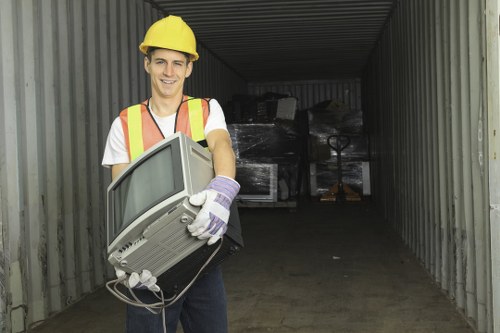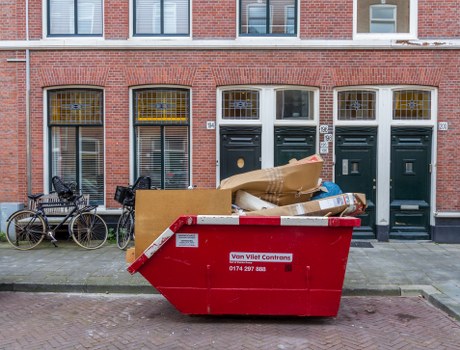Comprehensive Guide to Construction Waste Clearance in Sidcup
Understanding Construction Waste Clearance

Construction waste clearance is a critical service for managing the debris generated from construction projects. Whether you're renovating your home, building a new structure, or undertaking commercial construction, proper waste management ensures a clean and safe environment.
In Sidcup, a bustling area with numerous construction activities, efficient waste clearance services are essential. They help maintain the aesthetics of the neighborhood, prevent environmental degradation, and comply with local regulations.
Choosing the right waste clearance service can significantly impact the efficiency of your project. It ensures that waste is disposed of responsibly, recycled when possible, and minimized to reduce environmental footprints.
Why Proper Waste Clearance Matters

Proper construction waste clearance has multiple benefits:
- Environmental Protection: Proper disposal and recycling of waste materials help in reducing landfill usage and conserving natural resources.
- Safety: Clearing waste from construction sites minimizes hazards, preventing accidents and ensuring the safety of workers and the public.
- Compliance: Adhering to local regulations in Sidcup avoids legal penalties and promotes sustainable construction practices.
Ignoring waste clearance can lead to environmental pollution, health risks, and legal issues, which can delay your project and increase costs.
Services Offered by Construction Waste Clearance Companies

Construction waste clearance companies in Sidcup provide a range of services tailored to meet the unique needs of each project. These services include:
- Debris Removal: Efficient removal of construction debris such as bricks, concrete, wood, and metals.
- Recycling Services: Sorting and recycling materials to minimize waste sent to landfills.
- Hazardous Waste Management: Safe disposal of hazardous materials like asbestos, chemicals, and paints.
- Site Cleanup: Comprehensive cleaning services to ensure the construction site is safe and presentable.
Each service is designed to cater to different aspects of waste management, ensuring comprehensive coverage for all construction projects.
Benefits of Professional Waste Clearance

Hiring a professional construction waste clearance service in Sidcup offers several advantages:
- Efficiency: Professionals have the expertise and equipment to handle large volumes of waste quickly.
- Cost-Effective: Reduces the need for in-house waste management, saving time and resources.
- Environmental Responsibility: Ensures waste is disposed of in an eco-friendly manner, contributing to sustainability efforts.
- Regulatory Compliance: Keeps your project in line with local waste management laws and standards.
These benefits not only enhance the efficiency of your construction project but also promote responsible environmental practices.
Choosing the Right Waste Clearance Service in Sidcup

When selecting a construction waste clearance service in Sidcup, consider the following factors:
- Experience: Look for companies with a proven track record in handling construction waste.
- Licensing and Certification: Ensure the company complies with local regulations and has the necessary certifications.
- Range of Services: Choose a provider that offers comprehensive services tailored to your project’s needs.
- Customer Reviews: Check testimonials and reviews to gauge the company’s reliability and quality of service.
- Pricing: Compare quotes to ensure you receive competitive pricing without compromising on service quality.
By carefully evaluating these factors, you can select a waste clearance service that aligns with your project requirements and sustainability goals.
Environmental Impact of Construction Waste
The accumulation of construction waste has significant environmental consequences. Improper disposal can lead to soil and water contamination, increased greenhouse gas emissions, and loss of biodiversity.
Recycling construction materials helps in conserving resources and reducing the carbon footprint of your project. Metals, wood, and concrete can often be repurposed, promoting a circular economy.
Implementing effective waste management practices contributes to the broader goal of environmental sustainability, making your construction project more eco-friendly.
Regulations Governing Waste Clearance in Sidcup
Sidcup has specific regulations governing the disposal of construction waste. These regulations are designed to minimize environmental impact and ensure public safety.
Compliance with these laws is mandatory for all construction projects. Failure to adhere can result in fines, project delays, and legal complications.
Professional waste clearance services are well-versed in these regulations and can help ensure your project remains compliant.
Innovations in Waste Management
The construction industry is continually evolving, with new technologies and methods enhancing waste management practices. Innovations such as automated sorting systems, advanced recycling techniques, and sustainable materials are transforming how waste is handled.
Adopting these innovations can lead to more efficient waste clearance, higher recycling rates, and reduced environmental impact.
Staying updated with the latest advancements ensures that your waste management practices remain effective and sustainable.
Cost Factors in Waste Clearance
The cost of construction waste clearance can vary based on several factors:
- Volume of Waste: Larger projects generate more waste, increasing disposal costs.
- Type of Waste: Hazardous or specialized waste requires specific handling, which can be more expensive.
- Frequency of Service: Regular clearance services might be more cost-effective for ongoing projects.
- Location: Proximity to disposal sites can affect transportation costs.
Understanding these factors helps in budgeting effectively for waste management services, ensuring that you allocate sufficient resources without overspending.
Sustainable Practices in Waste Clearance
Embracing sustainable practices in construction waste clearance is essential for reducing environmental impact. This includes:
- Recycling and Reuse: Prioritizing the recycling of materials to minimize landfill usage.
- Reducing Waste: Implementing strategies to cut down waste generation at the source.
- Energy-Efficient Disposal: Utilizing methods that consume less energy during waste processing.
- Eco-Friendly Transportation: Using vehicles with lower emissions for waste transportation.
These practices not only benefit the environment but also enhance the sustainability profile of your construction projects.
Case Studies: Effective Waste Clearance in Sidcup
Examining successful waste clearance projects in Sidcup provides valuable insights into best practices.
For instance, a recent commercial development utilized a comprehensive waste management plan that included recycling concrete and metals, significantly reducing landfill waste.
Another residential project implemented phased waste clearance, ensuring that debris was managed efficiently throughout the construction process, minimizing site clutter and hazards.
Future Trends in Construction Waste Clearance
The future of construction waste clearance is leaning towards increased automation, advanced recycling technologies, and greater emphasis on sustainability.
Smart waste management systems that use data analytics to optimize waste collection routes and schedules are becoming more prevalent.
Additionally, the use of sustainable materials and modular construction techniques is expected to reduce waste generation, further enhancing the efficiency of waste clearance services.
Choosing Sustainable Materials
Opting for sustainable building materials is a proactive approach to reducing construction waste. Materials like reclaimed wood, recycled metal, and eco-friendly concrete alternatives contribute to lower waste production.
These materials not only minimize environmental impact but also often offer superior durability and aesthetics, adding value to your construction project.
Integrating sustainable materials into your project aligns with global sustainability goals and promotes responsible construction practices.
Implementing a Waste Management Plan
A well-structured waste management plan is essential for efficient construction waste clearance. Key components include:
- Waste Audit: Assessing the types and amounts of waste your project will generate.
- Clearance Schedule: Establishing a timeline for regular waste removal.
- Recycling Strategy: Identifying materials that can be recycled and setting up necessary processes.
- Compliance Checklist: Ensuring all waste disposal activities adhere to local regulations.
Having a detailed plan ensures that waste clearance is managed effectively, reducing disruptions and enhancing project efficiency.
Training and Safety in Waste Management
Proper training for personnel involved in waste clearance is crucial for maintaining safety and efficiency. Training programs should cover:
- Handling Hazardous Materials: Procedures for safely managing and disposing of dangerous waste.
- Use of Equipment: Training on operating waste clearance machinery and tools.
- Safety Protocols: Guidelines to prevent accidents and ensure a secure work environment.
- Environmental Best Practices: Techniques for minimizing environmental impact during waste management.
Investing in training enhances the quality of waste clearance services and promotes a culture of safety and responsibility.
Technology in Waste Clearance
Advancements in technology are revolutionizing construction waste clearance. Innovations include:
- Automated Sorting Systems: Enhancing the efficiency of recycling processes by accurately sorting waste materials.
- GPS Tracking: Monitoring waste collection vehicles to optimize routes and reduce fuel consumption.
- Waste Tracking Software: Managing waste data to improve transparency and accountability in waste disposal.
- Robotics: Using automated machines for repetitive and hazardous waste handling tasks.
Integrating these technologies into waste clearance operations leads to higher efficiency, lower costs, and improved environmental outcomes.
Community Impact of Construction Waste Clearance
Effective waste clearance has a positive impact on the local community. It enhances the visual appeal of neighborhoods, reduces health hazards associated with debris, and fosters a cleaner living environment.
Moreover, responsible waste management contributes to community well-being by reducing pollution and promoting sustainable practices.
Engaging with local communities and addressing their concerns regarding waste management fosters trust and cooperation, ensuring smoother project execution.
Conclusion
Construction waste clearance in Sidcup is a vital component of responsible and sustainable construction practices. By understanding its importance, selecting the right service provider, and implementing effective waste management strategies, you can ensure the success of your construction projects while minimizing environmental impact.
Embrace sustainable practices, stay informed about regulations, and leverage advanced technologies to optimize your waste clearance processes.
Contact us today to learn more about our professional construction waste clearance services in Sidcup and take the first step towards a cleaner, greener construction project.